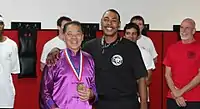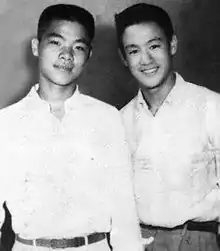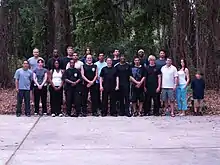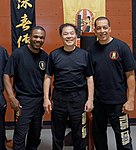William Cheung
William Cheung or Cheung Cheuk Hing (張卓慶, pinyin: Zhāng Zhuóqìng), born October, 1940, is a Hong Kong Wing Chun kung fu practitioner and currently the Grandmaster of his lineage of Wing Chun, entitled Traditional Wing Chun (TWC). He also heads the sanctioning body of TWC, the Global Traditional Wing Chun Kung Fu Association (GTWCKFA).[3] Cheung is responsible for introducing Bruce Lee to his master Ip Man when they were teenagers in Hong Kong.[4]
| William Cheung | |
|---|---|
 William Cheung with one of his students Anthony Arnett. | |
| Born | 1940 (age 80–81) Hong Kong |
| Other names | 張卓慶, Cheung Cheuk Hing |
| Residence | Victoria, Australia |
| Style | Traditional Wing Chun (TWC) Kung Fu |
| Teacher(s) | Ip Man |
| Rank | Grandmaster |
| Notable students | Eric Oram[1] Anthony Arnett[2] |
| Website | www |
Early life
In the 1950s Cheung grew up in Kowloon, where fighting skills were considered a measure of self-worth and pride, At age 11, Cheung's challenge matches were on the school playground and his fighting style was Tai Chi Chuan, which was not sufficient to elevate him among the youth of Hong Kong. This fighting was a concern and frowned upon by his father who was a police inspector; hence Cheung avoided becoming involved in gangs. By his teenage years however the challenge fights continued, and—as they are inextricably linked to extortion rackets of secret societies—Cheung's high-achieving family saw him as a source of embarrassment.[4]
A turning point in Cheung's life was when a gang leader who was undefeated in combat challenged an old man who was rumored to fight in a little–known Kung Fu style of a woman. Cheung witnessed the challenge and watched as the thin old man who was Ip Man quickly defeated the gang leader. Impressed by the old man's skill, Cheung visited Ip Man and became his student. Over the next few months Cheung became a favorite of Ip Man and became a live–in student for 3 years, before leaving Hong Kong.[4]
Friendship with Bruce Lee

During his time living with Ip Man, Cheung introduced a then 15–year–old famous child actor, Bruce Lee,[3] whom he first met at Lee's 9th birthday to Ip Man.[5] Originally Ip Man had rejected Bruce the right to learn Wing Chun Kung Fu under him because of the long standing rule in the Chinese Martial Arts world to not teach foreigners. His one quarter German background from his mother's side would be an initial obstacle towards his Wing Chun training. However Cheung would speak on his behalf and Lee was accepted into the school.[6]
Cheung and Lee became friends and training partners and after several months of training every day they both became more involved in street challenge fights until one day Cheung fought a triad leader and seriously wounded him. This prompted Cheung's father to send him away from Hong Kong to put him out of harm's way; however, the problems followed him, and he and his family decided that it was better for his safety to migrate to Australia to begin a new life.[4]
Bruce Lee acknowledged that while in Hong Kong, he saw Cheung as one of the best fighters.[7]
Accomplishments

Teaching traditional Wing Chun
After moving to Melbourne, Australia to teach Traditional Wing Chun professionally in 1973, Cheung established his Wing Chun studio in Melbourne's CBD. According to The Sydney Morning Herald, his studio attracts hundreds of new students each year.[5]
Cheung trained students in the US as well, including some who became successful in their martial arts careers, such as Eric Oram who went on to train Robert Downey Jr. and Christian Bale in preparation for their Hollywood movie roles.[8][9][1]
He also trained Anthony Arnett who has been winning martial arts tournaments since 1974 and has won grand champion multiple times some of which were for 3 years and 6 years running in different tournament circuits.[2]
Cheung taught unarmed combat to the U.S. marines of the Seventh Fleet based in Yokosuka, Japan.[10]

Martial arts
Cheung was acknowledged as one of Yip Man’s disciples who helped to firmly establish Wing Chun’s reputation as a fighting art through the challenge matches in Hong Kong.[11]
After being involved in duels with several triad members he had defeated in China, Cheung had reason to fear for his life, so he decided to migrate to Australia in 1957. On the way there an incident occurred when he was forced to fight more than 10 sailors who were set up by the triads that sought revenge. Cheung sustained several stab wounds from the fight as some of the men were armed.[5]
In 1984 Cheung set a world speed punching record of 8.3 punches per second at Harvard University in Boston.[12]
Awards
- Black Belt Hall of Fame Award - Kung Fu Artist of the year 1983[4]
- Inside Kung Fu Hall of Fame Award - Instructor of the year 1989[4]
Magazine front covers
Over a 28-year period Cheung has been featured on the front cover of 35 magazines between 1982 and 2010, the first being Inside Kung Fu in October 1982 and the most recent Martial Arts Illustrated in April 2010.[13]
Academia
Cheung attained a Bachelor of Economics from the Australian National University, after graduating from secondary school in Hong Kong. Cheung is a certified Doctor of Chinese Medicine under the Chinese Medicine Registration Board of Victoria, and a member of the Australian Chinese Traditional Orthopaedics Association Inc. He has also been invited as a Guest Professor to Foshan Sports University (China), and as a Senior Research Professor of the Bone Research Department to Beijing Chinese Medical University (China).[3]
Bibliography
- Cheung, William (1983). Wing Chun Bil Jee, the Deadly Art of Thrusting Fingers. Unique Publications. p. 160. ISBN 978-0-86568-045-6.
- Cheung, William (1986). Kung Fu: Butterfly Swords. Ohara Publications Inc. pp. 223. ISBN 0-89750-125-X
- Cheung, William; Mike Lee (1986). How to Develop Chi Power. Black Belt Communications. p. 192. ISBN 978-0-89750-110-1.
- Cheung, William; Mike Lee (1989). Kung Fu Dragon Pole. Black Belt Communications. p. 128. ISBN 978-0-89750-107-1.
- Cheung, William; Mike Lee (1988). Advanced Wing Chun. Black Belt Communications. p. 256. ISBN 978-0-89750-118-7.
- Cheung, William; Ted Wong (1990). Wing Chun Kung Fu/Jeet Kune Do: a Comparison Volume 1. Black Belt Communications. p. 192. ISBN 978-0-89750-124-8.
- Cheung, William (1989). My Life with Wing Chun (second edition). pp. 192.
- Cheung, William (2007). Wing Chun: Advanced Training and Applications. Black Belt Communications LLC. pp. 175. ISBN 0-89750-157-8. ISBN 978-0-89750-157-6.
- Cheung, William (2005). City of Dragons: Ah Hing - The Dragon Warrior. Healthworld Enterprises Pty. Ltd. pp. 118.
- Cheung, William (1994). CMT: Cheung's Meridian Therapy. Cheung's Better Life. pp. 388.
Videos
Cheung has produced a number of videos, including;
- The Wing Chun Way
- Tao of Wing Chun
- My Life with Wing Chun
- Wing Chun – Advanced Training and Applications
- City of Dragons
- CMT – Cheung's Meridian Therapy
- PRO-TEKT: A Personal Protection Program
References
- "Kung Fu Masters and Celebrity Students". Gamer Guide to Kung Fu (Online). 2015 ‐ 2017 Mark Media Corp. 24 June 2015. Archived from the original on 8 January 2017. Retrieved 7 January 2017.
- Diaz, Raquel (9 June 2016). "Continua la jornada de éxitos en la academia". Latin Australian Times (National print edition).
- "Kaleidoscope Chinese Kungfu". cultural-china.com. 2007-2014 cultural-china.com. Archived from the original on 26 December 2016. Retrieved 26 December 2016.
- De Roche, Everett (June 1989). "William Cheung Scene one... Take One". Australasian Blitz Magazine (Print edition Vol.3 No.3). Blitz Publishers ISSN 0818-9595. Gordon and Gotch Ltd. Retrieved 12 January 2017.
- Lallo, Michael (20 January 2011). "All the right moves". The Sydney Morning Herald (onliine). Fairfax Media. Retrieved 26 December 2016.
- Chen, Edwin (5 January 2016). "Bruce Lee Was an Anchor Baby". asamnews.com (Online). AsAmNews. Retrieved 1 November 2020.
- Shun-leung, Wong (1978). Reminiscence of Bruce Lee (Print ed.). Hong Kong, China: Wong Shun-leung. Retrieved 1 November 2020.
- "ROBERT DOWNEY JR. Martial Arts Master Says KUNG FU A KEY TO SOBRIETY". TMZ (online). 2016 EHM PRODUCTIONS. 25 December 2015. Retrieved 26 December 2016.
- John, Citrone (5 June 2003). "Fight Club: Kung Fu Master Anthony Arnett delivers street justice with an open heart and closed fist". Folio Weekly news magazine (Print edition front cover). Folio Weekly. Retrieved 26 December 2016.
- Ted Wong, William Cheung (1 December 1990). Wing Chun Kung Fu / Jeet Kune Do: A comparison (Paperback ed.). United States of America: Ohara publications Inc. ISBN 0-89750-124-1.
- Ritchie, Rene (15 June 1998). Complete Wing Chun: The Definitive Guide to Wing Chun’s History and Traditions (Print paper back ed.). Tuttle Publishing. p. 8.
- William, Cheung (1988). Advanced Wing Chun (1 ed.). USA: Ohara Publications. p. 7. ISBN 978-0-89750-118-7.
- "Resource for Martial Arts Magazines". Ma-mags.com. Ma-mags. Retrieved 26 December 2016.